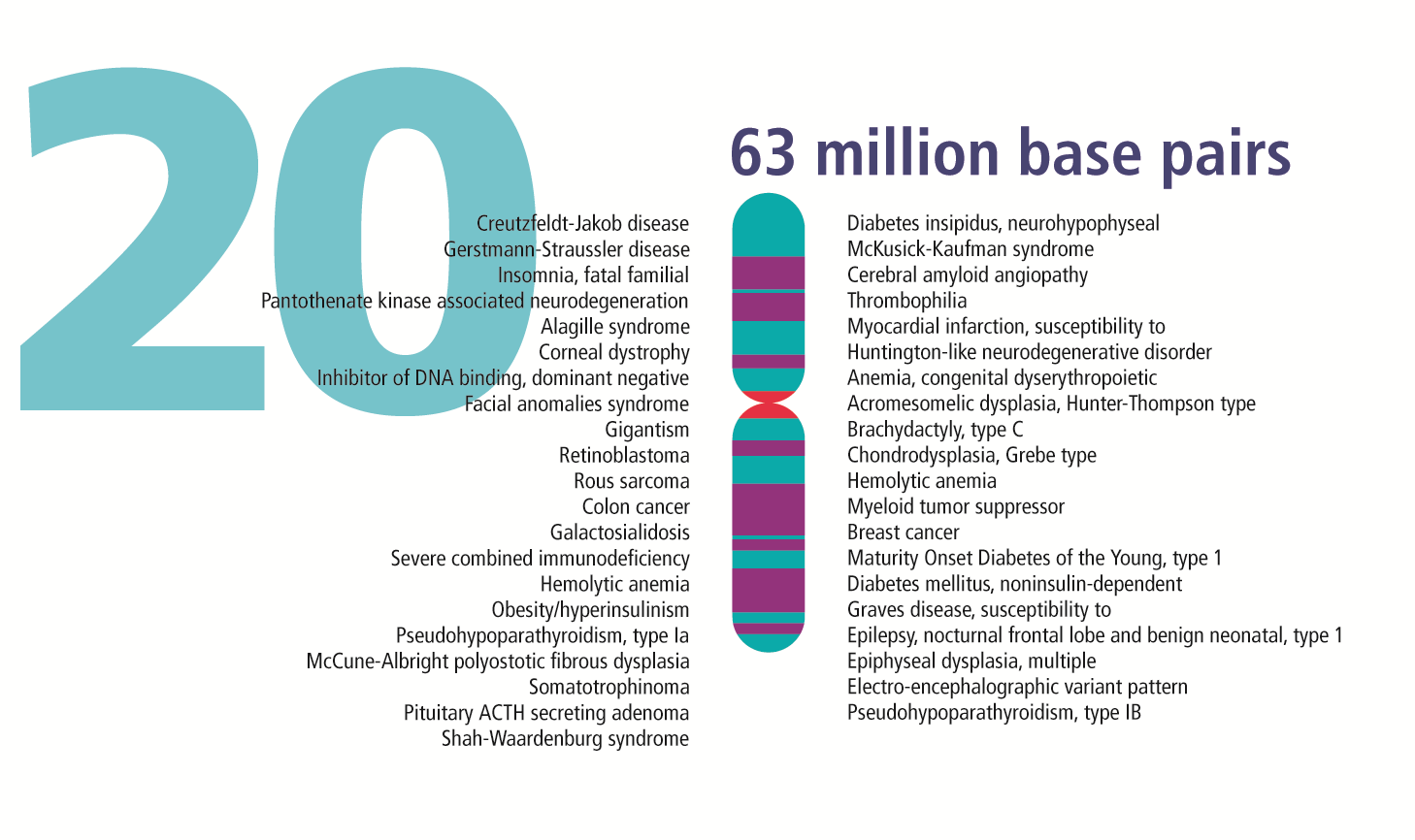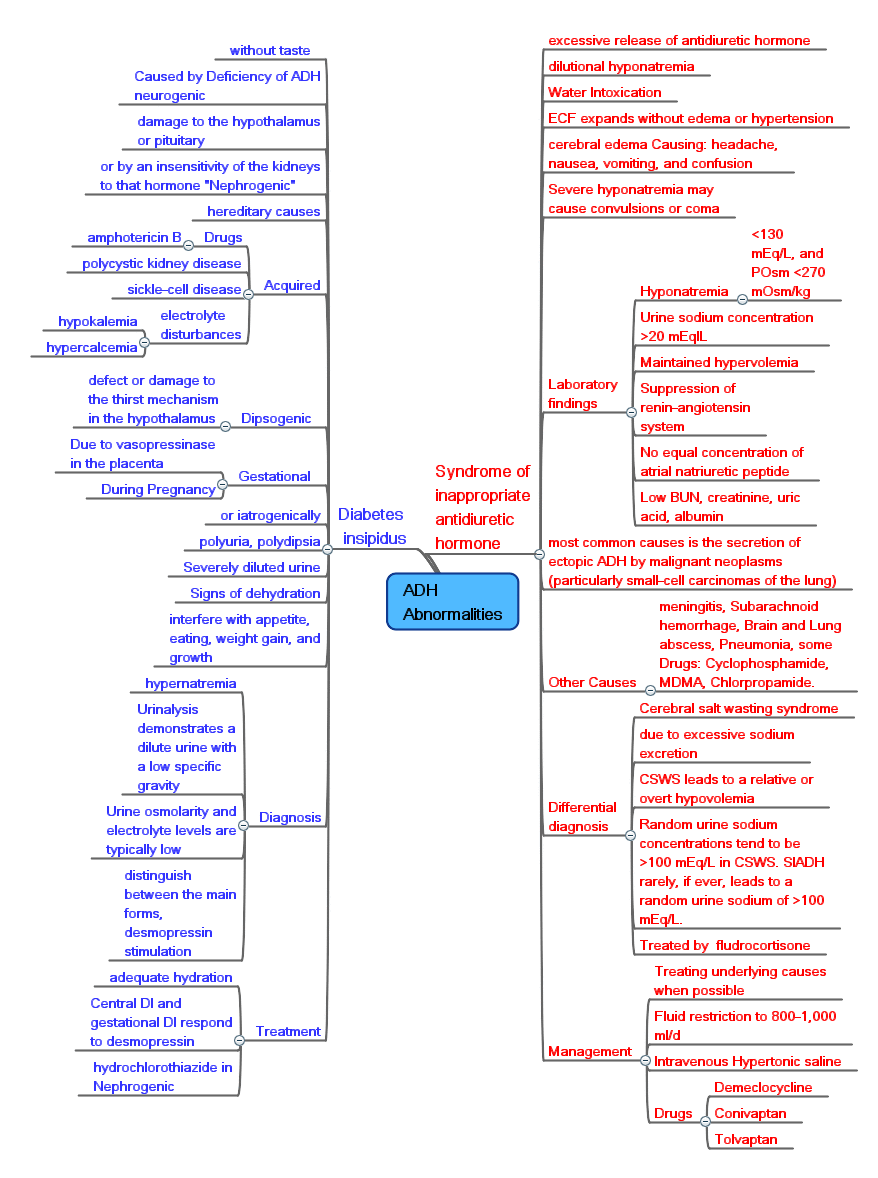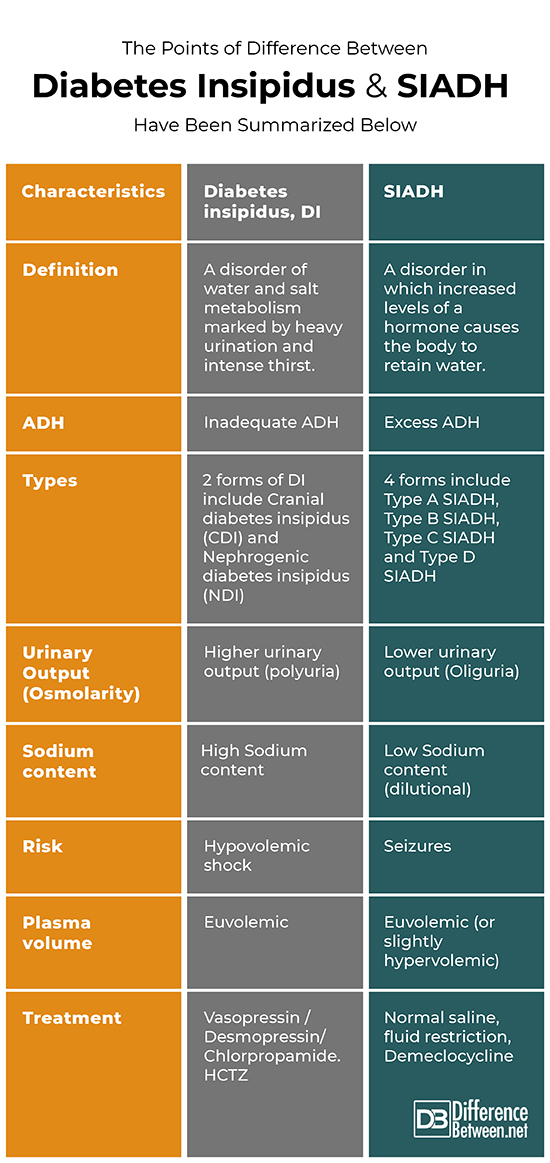Difference Between Diabetes Insipidus and SIADH
What is Diabetes Insipidus (DI) and SIADH
Both Diabetes Insipidus (DI) and Syndrome of Inappropriate Antidiuretic Hormone Secretion (SIADH) are both disorders of water regulation impacting the release or activity of anti-diuretic hormone (ADH) in the body.
In SIADH, Antidiuretic hormone is not suppressed causing significant electrolyte abnormalities and water retention. In Diabetes insipidus (DI), there is either lowered production of Antidiuretic hormone (central DI), or normal Antidiuretic hormone secretion with resistance in the kidneys to its impacts (nephrogenic Diabetes insipidus). The net result of Diabetes insipidus is huge amount of diuresis of dilute urine.

Diabetes Insipidus
In diabetes insipidus, or DI, the body releases too less anti-diuretic hormone (ADH). It is a disorder of water and salt metabolism marked by extreme thirst and heavy urination. Diabetes insipidus DI takes place when the body is unable to regulate the fluids. The disorder is caused by a hormonal abnormality and is not related to diabetes.

SIADH
SIADH means Syndrome of inappropriate antidiuretic hormone secretion. It is a medical condition in which higher levels of antidiuretic hormone (ADH) is made by the body. Due to higher concentration of ADH, the body retains huge amount of water. This process upsets the mineral (electrolytes) balance in the body, particularly sodium.
This ADH assists the kidneys control the quantity of water the body loses through the urine. Syndrome of inappropriate antidiuretic hormone results in too much retention of water by the body.
Difference between Diabetes Insipidus and SIADH
Description
Diabetes Insipidus, DI
It is a medical condition or disorder of water and salt metabolism marked by heavy urination and intense thirst.
SIADH
SIADH means Syndrome of Inappropriate Antidiuretic Hormone Secretion (SIADH).
This disorder is characterized by an increased and unsuppressible release of ADH either from an abnormal non-pituitary source and posterior pituitary gland. Unsuppressed Antidiuretic hormone causes an unrelenting elevation in solute-free water getting returned by the tubules of the kidney to the venous circulation.
Causes
Diabetes insipidus, DI
Causes of DI (Diabetes Insipidus) include:
- Kidneys are not receptive to antidiuretic hormone secretion (ADH)
- Tumour
- Harm to the hypothalamus and/or the pituitary gland
- Brain damage or trauma through head injury or stroke
- Complications that happen during pituitary surgery or brain
- Drugs like Declomycin. This drug inhibits ADH production.
SIADH
Causes of SIADH include;
- Mental status changes
- Nausea, vomiting, Coma, Cerebral oedema, seizures
- Liver disease
- Hypothyroidism
- Adrenal insufficiency
- Eco-topic tumour production
- Pulmonary disease/lung cancer
- Guillain-Barré syndrome (a medical condition that is reversible which impacts the nerves in the body. Guillain-Barré syndrome can lead to muscle pain, weakness, and even temporary paralysis of the chest, facial, and leg muscles. Paralysis of the chest muscles can lead to breathing disorders)
Symptoms
Diabetes insipidus, ID
- Too much thirst
- Increased urge too pee during the night
- Cravings for cold drinks
- Producing huge amounts of diluted urine
An infant or small child with diabetes insipidus may show the following signs and symptoms:
- Wet and heavy diapers
- Sleeping disorders
- Fever
- Accelerated heart rate
- Bed-wetting
- Delayed growth
- Puking
- Low blood pressure (hypotension)
- Acute constipation
- Weight loss
SIADH
- Vomiting or nausea
- Depressed mood, memory impairment
- Tremors or cramps
- Irritability
- Seizures
- Personality changes, such as confusion, combativeness, and hallucinations
- Coma or stupor
Diagnosis Methods
Diabetes insipidus, ID
Diabetes insipidus ID is diagnosed using several tests including:
- Physical examination
- Urine analysis
- Medical history
- Water deprivation test (to find out how much urine is passed)
- Assessment of electrolyte levels – Blood tests
- Computed tomography (CT) scans.
- Magnetic resonance imaging (MRI) scan of the brain
SIADH
- Biochemistry tests to find out serum sodium level
- Urine osmolality (random sample collected at same time as serum sample)
- Serum osmolality
- Thyroid function tests
- Early morning cortisol level
- Computed tomography (CT) of the head in case of a neurosurgical condition (example subdural haematoma, subarachnoid haemorrhage)
- Chest X-ray in case SIADH is caused due to pulmonary reasons.
Treatment
Diabetes insipidus, ID
Treatment choices for the common types of diabetes insipidus are discussed below:
Central diabetes insipidus
- This treatment involves treatment with a man-made hormone known as desmopressin (DDAVP, Minirin, others). This medicine replaces the missing ADH (anti-diuretic hormone) and bring down peeing capacity.
- Other medications are also prescribed, such as chlorpropamide and indomethacin (Tivorbex, Indocin). These medications can make anti-diuretic hormone (ADH) more available in the body.
Nephrogenic diabetes insipidus
- In this treatment, doctors will prescribe a low-salt diet to assist in decreasing the amount of urine the kidneys make. Drinking enough water to avoid dehydration is also recommended. Medicines like hydrochlorothiazide (Microzide) helps in improving the symptoms.
Gestational diabetes insipidus
- Treatment for gestational diabetes insipidus is with the synthetic hormone desmopressin.
Primary polydipsia
- This kind of treatment involves decreasing the intake of fluid. If Primary polydipsia is related to a mental illness, treatment and addressing the mental illness will help in relieving the diabetes insipidus symptoms.
SIADH
Treatment includes:
Medications
Drugs for treatment include:
- Demeclocycline – the most potent inhibitor of Vasopressin (ADH/AVP) action.
- An antagonist of the V2 vasopressin receptor -Tolvaptan
- An antagonist of both V1A and V2 vasopressin receptors – Conivaptan
Diuretic
Increases urine production to remove excess water and salt.
Antibiotics
Kills or stops the growth of bacteria.
If the SIADH condition is chronic, fluid restriction has to be permanently followed. Treatment may also include:
- Surgically remove the tumour that is producing anti-diuretic hormone (ADH)
- Drugs like vasopressin that inhibit the action of anti-diuretic hormone (ADH)
- Other medications that help to regulate body fluid volume
Summary
The points of difference between Diabetes insipidus and SIADH have been summarized below:

- Difference Between Global Warming and Greenhouse Effect - May 18, 2024
- Difference Between Vaccination and Immunization - March 3, 2024
- Difference Between Selective Mutism and Autism - February 25, 2024
Search DifferenceBetween.net :
2 Comments
Leave a Response
References :
[0]Ball, S. (2013). Diabetes insipidus. Medicine, 41(9), 519-521.
[1]Lu, H. J. (2017). Diabetes insipidus. In Aquaporins (pp. 213-225). Springer, Dordrecht.
[2]Zhu, C. G., Zhang, Q. Z., Zhu, M., Zhai, Q. L., Liang, X. Y., Shao, Z. H., ... & Qu, H. Q. (2013). A case report of syndrome of inappropriate antidiuretic hormone secretion with Castleman’s disease and lymphoma. BMC endocrine disorders, 13(1), 19.
[3]Image credit: https://en.wikipedia.org/wiki/File:Human_chromosome_20_from_Gene_Gateway_-_with_label.png
[4]Image credit: https://commons.wikimedia.org/wiki/File:ADH_Abnormalities.png

With active agent Sildenafil Citrate, MALEGRA 100 MG vows to give affirming effect against the pandemic sexual disorder— erectile dysfunction (ED) in men and prevents cGMP for penile erection
thank you for this information because I never understood what type of di I had or the difference between each of them. I have been trying to find more information on how diabetes type 2 can affect my di. I am not diabetic but because I am latino my chances of getting type 2 diabetes is greater especially because my mother has it and my father died due to complications of diabetes. how will my body respond If I do get type 2 diabetes and what can I expect when having both di and type 2 diabetes